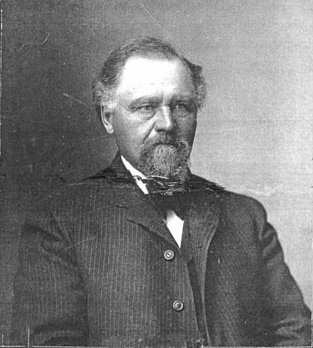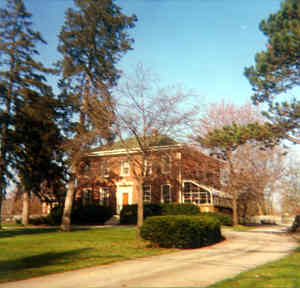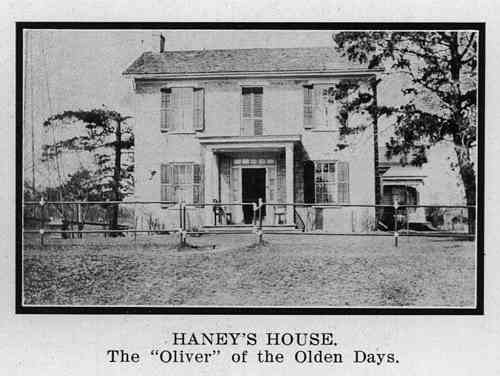
Notre Dame's Grotto / by Dorothy V. Corson

More Pieces in the Puzzle
With Father Maguire's letter as a guide, more pieces in the puzzle of the story behind the Grotto began to fit into place. A picture of the times and the people involved when the 1896 Grotto was erected, began to take shape.
Financial entries in an 1896 ledger(132) at the University Archives listed the expenses for the present Grotto. The first entry appeared on June 6, 1896: Item No. 1113, $500 "pd. on contr." to Gill the contractor. Further on was another $500 entry with the names McCoy and Gill etc. The existence of a John Gill, masonry contractor, was verified in the 1896 City Directory.
So Peter Kintz and his sons had not actually built the Grotto. Instead, they must have "helped build it" upon delivering their stone to the Grotto. An entry in the same ledger listed "Milk and Meat" sold to the campus by the Kintz family near the time the Grotto was being built. This item confirmed their close ties to Notre Dame.
Researching this family's history and their relationship to the campus added the names of more people and events associated with the building of the Grotto. It also involved more and more unexplored areas --plat books, census records, old 1896 newspapers, and records of deeds in the recorder's office at the County-City Building.
These records proved invaluable in "fleshing out" the history of the University and the farm families surrounding it in the last quarter of the 19th century. They supplied more evidence of the interaction between townspeople and Notre Dame and St. Mary's from earliest times.
While browsing through those old records this pensive poem spoke from the pages of an old Scholastic, like a voice from those bygone days. It was written one hundred and twenty-three years ago:
| A Hundred Years to Come Who'll press for gold this crowded street
|
It is interesting to find the "Who" in Coz's poem embodied in this generation one hundred years after the 1896 Grotto was built.
More Notre Dame connections began to appear in digging more deeply into the Kintz family heritage. Cecelia Kintz, a daughter of Peter Kintz II, was the mother of Carmelita Roemer who was the mother of Mary Roemer and James A. Roemer, the present Director of Community Relations at the University of Notre Dame, and the grandmother of Congressman Tim Roemer. All are alumni of Notre Dame along with many others in their family. James Roemer said the story of his ancestor, Peter Kintz II, helping to build the Grotto had been passed down on his side of the family as well. It was Mary Roemer who recalled the story of the statue being delivered from the train station by a team of white horses.
Sister Cecile Marie Luther, former principal of St. Mary's Academy, and Sister Helen Therese Matras, Holy Cross Sisters at St. Mary's Convent, are both descended from this same Peter Kintz family and both told the same story. Sister Cecile Marie recalled the many times she had gone to the Grotto and said the same prayer: "Dear Lord up above, do you remember when my Grandfather Peter Kintz brought huge big boulders from his farm to build this Grotto so that Our Lady could be honored on this spot? Blessed Mother be sure to bless Peter Kintz and all his descendants."
 Sister Helen Therese's grandmother, Mary J. Lacose, married Maglorias Madra (Merit Metras). They were one of the first couples to be married in the Log Chapel, on September 29, 1856. He was the first layman Father Sorin hired to teach French at Notre Dame.(134)
Sister Helen Therese's grandmother, Mary J. Lacose, married Maglorias Madra (Merit Metras). They were one of the first couples to be married in the Log Chapel, on September 29, 1856. He was the first layman Father Sorin hired to teach French at Notre Dame.(134)
Another descendent of the Kintz family, Victor Couch, great grandson of Peter Kintz, also confirmed that farmers did masonry work on foundations, and carpentry in building barns, and many worked at Notre Dame in the winter when they were not farming.
His memories encompassed a maze of South Bend family names that touched Notre Dame and St. Mary's in countless ways and went back well over one hundred years. He, himself, has been an usher at Notre Dame Games for 52 years. He also remembers ushering for Rockne games, in 1928-29, when he was a 2nd class boy scout and there were wooden bleachers. He continues to farm ten acres of his family's land, located a mile North of the Notre Dame, and says the ground is still full of big rocks and boulders.
It was soon evident why this family had close ties with the University of Notre Dame and how they, and many other surrounding farm families, were connected with the doings on campus. He produced his abstract for the 80 acres of Kintz property, once part of the original 230 some acres of Talley land, which told a story in itself. It was from this property that Peter Kintz and his sons hauled boulders to be used in the Grotto.
 Alfred Talley, born in 1809, was the printer Sorin brought from Chicago to assist him in launching the Ave Maria in 1865. The first issue was printed in his home on Juniper Road. His home is still there, though it is now missing its cupola. It is a large red brick two-story house.(135) on the East side of Juniper Road, near Cleveland Road, about a mile North of the University of Notre Dame. An 1875 Atlas drawing of the Talley House and farm is pictured at the head of this chapter
Alfred Talley, born in 1809, was the printer Sorin brought from Chicago to assist him in launching the Ave Maria in 1865. The first issue was printed in his home on Juniper Road. His home is still there, though it is now missing its cupola. It is a large red brick two-story house.(135) on the East side of Juniper Road, near Cleveland Road, about a mile North of the University of Notre Dame. An 1875 Atlas drawing of the Talley House and farm is pictured at the head of this chapter
According to the Historic Preservation Commission, of South Bend, Indiana, the house received Landmark status in June of 1975, when it was bought by its last owner. It is still in the same family. It was purchased by the last owner's son, P. Reiley O'Connor.
Another lovely old home in the Roseland area, now only a memory, was pictured in The Dome with the words "The Pie House" written under it. Erma Helmen Post penned this interesting explanation of its connection to Notre Dame. "The Haney House was a favorite stopping place for Notre Dame Students. Back in those days students were not allowed to go into South Bend on their afternoon off, which was Thursday. Mrs. Haney's oldest daughter Kate started catering to a few students by serving them a cut of pie or cake with milk or coffee. Her popularity grew and on Thursday afternoon or on any other holiday, you would see students coming and going. It proved profitable to her and helped the family income which had been severely cut when the two grandsons, she had helped her mother and father raise, left the farm for more desired careers of their own. The Haney house was spacious and in inclement weather there was always room in the big dining room to care for the wants of the boys. The fame of the 'Pie House' was known all over the United States and in foreign countries just because one ambitious woman with a lot of Irish humor, knew how to bake good pies.

When asked if he'd ever heard of The Pie House, Father Carey's eyes lit up in remembrance. "Sure do," he said, "that was the old Haney House. Used to go there every Thursday. You could get a cut of pie or cake and a glass of milk for a dime.